Posted by Bob Martin on March 22nd, 2007
Now that I am over much of my 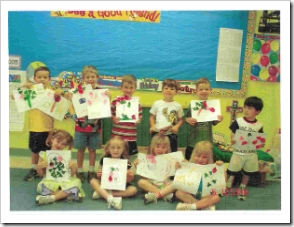 computer issues and can focus on art I came across a couple of photos (hidden on my PC) that I had forgotten about. Over the last ten years or more I’ve had an opportunity to be taught creativity by pre-school young people. When I am around a bunch of kids, I learn all over again that art like life is to serious to take seriously.
computer issues and can focus on art I came across a couple of photos (hidden on my PC) that I had forgotten about. Over the last ten years or more I’ve had an opportunity to be taught creativity by pre-school young people. When I am around a bunch of kids, I learn all over again that art like life is to serious to take seriously. 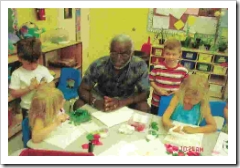 There is so much joy in watching kids paint flying dogs for Valentine’s Day or green hearts for Mother’s Day
There is so much joy in watching kids paint flying dogs for Valentine’s Day or green hearts for Mother’s Day
When ever I get an invitation to work with young people, I say sure, why not, I’ll be there. Then I experience an unimaginable fear as if I were meeting the Queen and I wonder why I did I say yes. The answers comes within two seconds after meeting the kids.
Posted by Dion on March 18th, 2007
In one of Robert Genn’s recent newsletters he talks about a study of creative children that grow into creative adults. The psychologist Ellen Winner found that creative people choose their path very early in life and they often have similarities like; scholastic boredom, difficulty making friends, and social problems.
Here’s some more characteristics of creative people from Robert’s article..
- Visual perceptions that transcend everyday life
- Heightened responses to natural surroundings
- Sustained high standards of work ethic
- Early presence of mentor(s)
- Early formation of personal identity
- Tendency to do things in unique ways
- Preference to work autonomously
- Defiance or suspicion of conventional thinking
I think I suffer from (or am blessed with?) all of the characteristics above. Another funny observation that I have made over the years is that artists generally like other artists. It’s almost like we have joined some special club where the members are connected on a lot of different levels.
Perhaps it is the same connection that firemen, plumbers, or accountants feel when they get together, but I think it’s something more.
Posted by Karl Zipser on February 1st, 2007

Painting
From Life vs.
From Photos

Detail from funeral pyre scene on an Attic Geometric krater, second half of 8th century BC
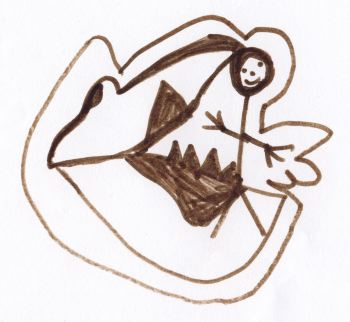
Man being eaten by a crocodile, first half of 21st century AD
The ceramic painting above I borrowed from Victor Bryant’s excellent ceramics website. The drawing on paper is by Fran, who is almost five years old.
The images are similar in that they both depict narrative scenes, and both make use of simple geometric shapes. The vase painting probably represents top quality artwork of its era, making use of a consistent representational system which covers this large vase and many others (presumably painted by many different adults working over many years). The children’s drawing is a one-of-a-kind sketch.
At first glance, the vase painting seems like children’s art made by adults. A key factor that distinguishes the adult work is the consistent repetition of patterns — across the detail, across the vase and across the historical period. There is a discipline here that is alien to the work of a child drawing as play. This use of repetition has substantial advantages. It imparts rhythm and complexity to the work that is lacking in Fran’s image. Repetition creates a decorative effect that masks to some degree the simplicity of the representation. For the sake of comparison, we can apply repetition to Fran’s image:
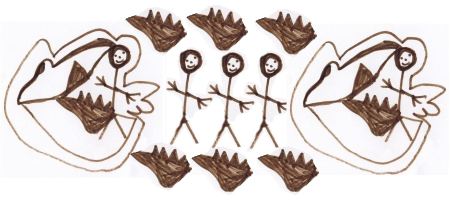
We can also isolate a figure from the vase painting. With these simple digital manipulation we have not transformed Fran into an Attic geometric vase painter, or turned the vase painter into a child. We have, I think, narrowed the gap.
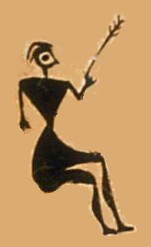
What I think is interesting here is that what presumably passed for fine work in the 8th century BC probably could be made by children, if they were compelled to work within a disciplined productive system (as the adults were).
Discipline and rigid compliance to style are factors that are quite contrary to our modern notions of art, however. Is the ancient vase painting art, or is it nothing more than systematized children’s decoration?
Posted by Hanneke van Oosterhout on January 25th, 2007
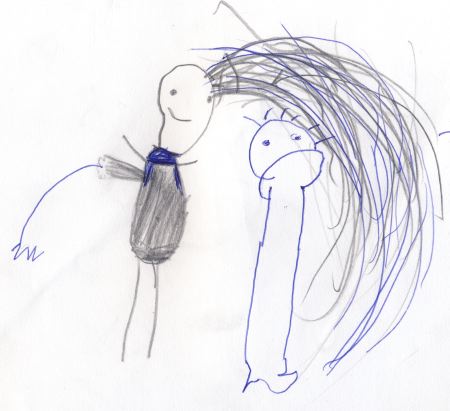
drawing by Françesca at age 3
I wanted to do a post about the drawings that my children made. I have an incredible amount of them (drawings, that is, plus five kids). The first thing was to choose and scan and crop and choose and scan and crop. more… »
Posted by Karl Zipser on January 18th, 2007

Red gauche on paper
Let’s for a moment accept the proposition that children artists can be considered “real artists.” What an odd type of artist a child makes, if you think about it. What a short career a child has as an artist, always in transition. Who could be worse at writing an artist’s statement than a child?
Please look at the painting above and ask yourself, what does it depict? I have looked at this artwork many times and I always have had more or less the same interpretation of the content. But what was the artist’s intention? Are our views similar? Why don’t I ask the artist? In fact, I am the artist. I painted this sometime during the early 1970’s, but I have no memory of doing so. I have no idea what I intended. I somehow doubt that my interpretation of the picture (which I remember from later in my childhood) is in fact what I was thinking when I painted it.
The painting is framed behind glass, which makes it difficult to photograph. My mother made frames for many of my sister’s and my artworks, without which they would certainly have been lost. Children’s art was the main artwork in our house when I was growing up. If it were not for this early encouragement, I probably would not have become an artist.
Do you frame your children’s art? Do you ever think of the long-term implications of doing so (or not doing so)?
. . .
[Update]
I enjoyed reading the different interpretations of this painting by Sunil, Steve, Rex, Leslie, June, and Birgit. I never had the idea of a giant figure on the right before, but Sunil’s comment made me look at the picture in a different way. An area of agreement is that the picture shows a man. I would really like to know what I thought I was doing when I made this.
I’ve been thinking about this picture a lot, about the role of the “artist.” Here is what I think: my mother’s role in this picture was something like that of a photographer. She didn’t “make” the image by hand, but she created the conditions for it to be made. Presumably it was one of many paintings. She selected this one, framed it and saved it. I think she chose this image for a reason, because it is a compelling. She could also have made a compelling photograph of a pattern of clouds in the sky that looked a lot like a man on a dock or a boat, or what have you. I think my role as a three or four year old painter is completely accidental.
Is children’s art art? It seems to me that it can be, but a parent or some adult has an important role to play in making it art — selecting what is good and presenting it as art.
[UPDATE 2]
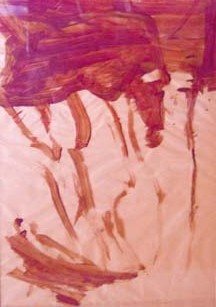
Posted by Karl Zipser on January 11th, 2007

Earlier we came to an informal consensus that children’s art is not real “art.” I don’t see that as a problem, but it makes me curious: what are children doing when they draw? To try to get some insight, I’ve been drawing together with Nino and Fran. more… »
Posted by Karl Zipser on January 4th, 2007
Is children’s art “art”? Steve said that age does not matter; Derek, June, Bob and Arthur were ambivalent. I thought I should ask a Françesca (four and a half years old) for her opinion about what she makes, and also about work by “grownups.”
more… »
 computer issues and can focus on art I came across a couple of photos (hidden on my PC) that I had forgotten about. Over the last ten years or more I’ve had an opportunity to be taught creativity by pre-school young people. When I am around a bunch of kids, I learn all over again that art like life is to serious to take seriously.
computer issues and can focus on art I came across a couple of photos (hidden on my PC) that I had forgotten about. Over the last ten years or more I’ve had an opportunity to be taught creativity by pre-school young people. When I am around a bunch of kids, I learn all over again that art like life is to serious to take seriously.  There is so much joy in watching kids paint flying dogs for Valentine’s Day or green hearts for Mother’s Day
There is so much joy in watching kids paint flying dogs for Valentine’s Day or green hearts for Mother’s Day







